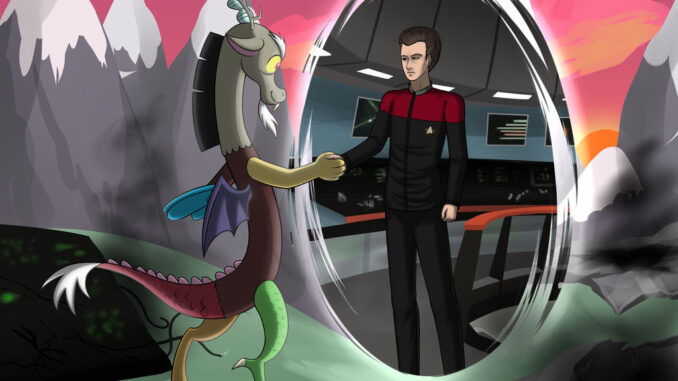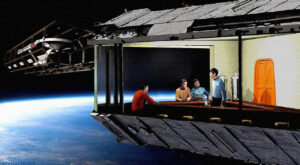
I n Call of Cthulhu’s A Time to Harvest the writers present an alternate final encounter for Lore Keepers who are using the Pulp Cthulhu rule set. This type of gaming rule set allows the Player Characters to directly take the fight against Mythos monsters without a guarantee of a TPK. The final chapter involves the characters passing through a portal and infiltrating a Mi-Go city on the dark side of the moon.
n Call of Cthulhu’s A Time to Harvest the writers present an alternate final encounter for Lore Keepers who are using the Pulp Cthulhu rule set. This type of gaming rule set allows the Player Characters to directly take the fight against Mythos monsters without a guarantee of a TPK. The final chapter involves the characters passing through a portal and infiltrating a Mi-Go city on the dark side of the moon.
In this city, the Mi-Go are building a portal to their home dimension, Once it’s complete, they’ll have easy access to their home and, more importantly to the characters, it will alter the fabric of the characters’ universe so it’s physically beneficial to the Mi-Go.
This makes it impossible for the universe to sustain human life.
So, the characters need to plant a bomb at the base of the portal, avoiding a shoggoth and robot portal builders, as well as a Mi-Go army. The obvious pulp tactic is to go all Leeroy Jenkins and make a direct assault on the construction site. Even pulp characters don’t stand much of a chance against a shoggoth.
The module encourages Keepers to allow a non-combat method of success, involving reconnaissance and stealthily moving between piles of debris.
The module reminds the Keeper there doesn’t need to be a singular combat-based solution to the encounter.
I was reminded of this when running my Star Trek Adventures campaign. I was using the Mission Brief from the Trade Ledgers compilation by Michael Dismuke, Bedlam on Baham. In this tale, the Federation intercedes when an alien ship shows up at a planet applying for Federation membership and threatens to exterminate all life on the planet if they don’t evacuate in seven days.
The crew finds out that beneath the capital city lies a research lab where coolers tried to preserve Tzenkathi biological samples in hopes of building a biological weapon to eliminate the Tzenkathi. The crew discovered most of the samples didn’t survive the eons of storage and took the remaining samples aboard their ship.
When the alien ship returned, the captain demanded the Federation ship leave in five minutes or be destroyed. The Captain of the Federation ship, USS Lexington, could have prepared for starship combat or played a game of cat and mouse with the aliens. Instead, she said the biological samples did not survive and she had the sole surviving samples. She’d negotiate the exchange of the samples if the aliens promised to leave the planet and never return.
This removed the need for immediate starship combat and opened the way for a roleplaying encounter. I probably should have used a stat block from the Ultimate Enemies pdf, which includes Q and Khan, but instead I opened my Delta Quadrant Sourcebook and turned to the stats for the Queen Borg. The module said to use the Borg Cube stats for the alien ship after all.
The Lexington Captain negotiated in her ready room with the alien leader. He wanted to see the samples and know they weren’t compromised. The Chief Medical Officer stopped trying to make potential antidotes to a biological weapon targeting Tzenkathi and prepared a viewing area behind a force field.
The alien leader agreed to the Lexington’s terms and promised to remain inactive in orbit for twenty four hours, after which time the samples would be beamed onto his ship.
There was no massive battle or starship combat. Instead, there was a heated discussion amongst the crew members about their potential involvement in xenocide if they let this plan go through, leading to crew members sabotaging the samples so they deteriorated after enough time had passed.
The roleplaying and tasks to sabotage the samples were much more rewarding than a tedious space battle. Values were challenged. Determination was spent.
The Security officer, who’d involved Section 31, plotted to take over the Lexington from the Captain if things did not go through properly. A lot was at stake. The players felt rewarded in their choices.
I could have had the alien leader refuse to talk. I might have made it impossible for the Captain to convince the alien leader to negotiate. I did make the target number quite high. But I opened my mind to a non-combat solution to this situation, resulting in a much more rewarding session.
In a game like Star Trek Adventures, characters should succeed more times than not by using their guile to outwit their opponents or by using their skills to make the impossible possible.
In games like Pulp Cthulhu it can be more difficult to offer non-combat solutions. By the game’s nature, the players might not consider a roleplaying solution as an option. As a responsible Keeper, rolls should be called for to see the clues that can be used to solve the situation with a non-combat alternative.
